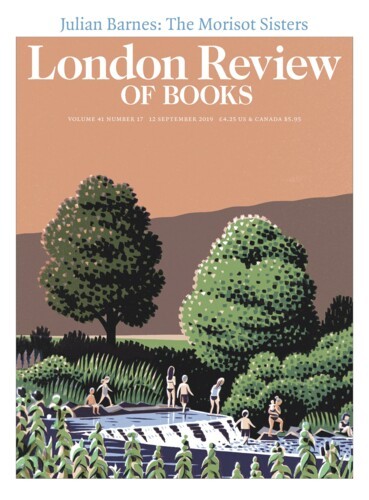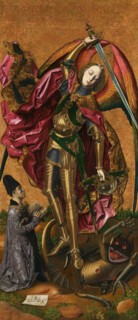Despite being the most imaginative Spanish painter of the 15th century, and the only one to master the illusionistic techniques pioneered by Jan Van Eyck, Bartolomé Bermejo’s small but spectacular body of work is little known. The National Gallery acquired the panel Saint Michael Triumphant over the Devil (below) from the sale of the Luton Hoo estate contents in 1995. In common with three of the four early works from Spain already in the gallery’s collection, the Bermejo was displayed with the Hans Memling paintings to which it is stylistically related, and little attention was paid to the saint, demon and pious benefactor praying for forgiveness. Early last year, however, the Prado finally accorded Bermejo the recognition he deserved, announcing that one of its bicentennial exhibitions would be dedicated to him. A smaller version of the show is now on display at the National Gallery (until 29 September) and Saint Michael’s delicate, androgynous features and rainbow-feathered wings have been restored for the occasion.
The Desplà Pietà, which hangs alongside Saint Michael as you enter the exhibition, was the first of Bermejo’s works to be rediscovered, rescuing him from centuries of oblivion. In 1839 a Spanish historian transcribed the name ‘Bartolomé Bermeio’, which was painted as if carved into the frame. It wasn’t until the early 20th century, several years after the diamond magnate Julius Wernher had bought Saint Michael as the work of an anonymous Provençal master, that further panels were added to Bermejo’s corpus (which now comprises about twenty works). These included the Triptych of the Virgin of Montserrat and four panels from a lost altarpiece, known as Christ the Redeemer, which are also on display at the National Gallery.
‘Bermejo’, Spanish for a variant of red, was a nickname the artist sometimes Latinised to ‘Rubeus’. His real name was Bartolomé de Cardenas, and although there is no record of his early life, we know from the inscription on the Pietà that he came from Córdoba. His surviving works are testament to 15th-century Spain’s obsession with all things Burgundian, particularly with the paintings of Van Eyck and Rogier Van der Weyden, which Bermejo often made reference to. Like these early Netherlandish masters, Bermejo used the verisimilitude made possible by new oil painting techniques to blur the boundary between the sacred and mundane. But Bermejo’s art is also distinctive, with sudden tonal contrasts and intense colours that reflect the harshness of life in his arid homeland in the early years of the Spanish Inquisition.
Bermejo had an itinerant life. He left Córdoba for Valencia, moved from there to Daroca and Saragossa in Aragon, and finally settled in Barcelona. The exhibition gives the chronology of Bermejo’s commissions in each of these places, referring to some of the issues that dogged his career: the need to ally himself with less skilled local masters to circumvent guild regulations, the threat of excommunication for failing to deliver finished work, and his association with conversos – converted Jews targeted by the Inquisition. Indeed, it is now thought that Bermejo was himself a ‘New Christian’ and that hostility from ‘Old Christians’ may have been one of the reasons for his frequent displacements.
The 1468 contract for Saint Michael, only discovered in the 1960s, reveals that Bermejo had been a citizen of Valencia since the early 1460s. The city was the largest port in the western Mediterranean and home to many foreign merchants and artists. Saint Michael was the central panel of a large altarpiece commissioned by Antoni Joan, lord of Tous (50 km from Valencia), and it is him we see praying for forgiveness in the painting. Joan was an influential figure with connections to the Aragonese and Castilian monarchs, the local nobility, and the Borgia popes Calixtus III and Alexander VI (who came from nearby Xàtiva). Given the sophisticated handling of oil paint in Saint Michael, and the skilled rendering of motifs such as the reflection of a skyline representing Jerusalem on the saint’s armour, it has long been assumed that Bermejo trained in Flanders, the artistic centre of the Burgundian Netherlands. Van Eyck’s work was not unknown to Valencian painters, but no other Spanish artist of this period achieved anything like Bermejo’s mastery of Netherlandish technique, and nothing is known about the only two Flemings living in Valencia who could perhaps have trained him. The Prado exhibition set out to question this assumption, and the National Gallery follows suit: in her catalogue essay the curator, Letizia Treves, describes the reflections and other Eyckian motifs as ‘superficial similarities’. It is true that certain aspects of Bermejo’s work are typically Valencian (the construction and preparation of the panels, for example, and the tooled gold background), but as essays by Lorne Campbell and Tobias Capwell confirm, the hypothesis that Bermejo visited Flanders is hard to dismiss.
Campbell draws attention to Bermejo’s use of compositional schemes developed by Van der Weyden, such as asymmetry and broken diagonals, and to Bermejo’s characteristically Netherlandish rendering of detail, for example the Pietà’s botanically accurate flowers (each variety representing a different quality associated with the Virgin Mary). Some of this could have come from drawings and prints circulating among Valencian artists and collectors, but it is harder to explain Bermejo’s remarkable rendering of texture and light. The reflections in the armour of his Saint Michael are similar in execution to those in Hans Memling’s Last Judgment triptych, commissioned in Bruges about the same time as Bermejo signed his contract with Antoni Joan. Memling almost certainly worked in Van der Weyden’s Brussels workshop before 1465 and modelled his own Saint Michael on the one in Van der Weyden’s Last Judgment in Beaune. Campbell suggests that Bermejo’s more dynamic saint – raising a sword over his shoulder and trampling the Devil – may be close to a lost painting by Van der Weyden that also inspired Memling. This hypothesis is strengthened by parallels between Bermejo’s saint and the gilded copper sculpture of Saint Michael mounted as a weathervane on Brussels Town Hall in 1455 (now in a local museum), which was probably designed by Van der Weyden – the town painter.
Capwell demonstrates in impressive detail that the armour worn by Bermejo’s saint is based, like the Brussels Town Hall sculpture, on careful observation of a real suit made in Italy for export to Western Europe. Bermejo’s armour is not only gold-plated, it boasts lush silk velvet covering the thorax, and pearls, cabochon rubies and lozenge sapphires decorating the plackart and sabatons, like those on the godlike kit made for Charles the Bold, duke of Burgundy. Both these decorative features and Bermejo’s Netherlandish fastidiousness in describing every plate, vambrace and voider are further reasons to believe that he spent time in the workshop of a prestigious Flemish master before 1468.
The Triptych of the Virgin of Montserrat (which usually hangs in the cathedral at Acqui Terme) was also painted in Valencia. We know from a later notarial record that it was commissioned by Francesco della Chiesa, a Piedmontese textile merchant based in the city for several decades. Here Bermejo joined forces with Rodrigo and Francisco de Osona, who painted the wings according to Bermejo’s designs. With no extant contract, the date of the triptych’s production has been much debated. At the Prado exhibition, a date of 1483-89 was suggested, but new technical investigation has brought it forward to 1470-75. Like Saint Michael, the work refers directly to the art of Flanders, with a typically Netherlandish triptych format, grisailles on the outer wings, accurately depicted plants, and a Virgin and Child borrowed from Dieric Bouts.
The four panels of Christ the Redeemer are again undocumented, but all clearly come from the same altarpiece. They are striking both for their emphasis on Christ’s humanity – his naked, resurrected body covered only in the sheerest of cloths – and for including (along with the Resurrection and Ascension) two unusual scenes, the Descent of Christ into Limbo and Christ with the Just in Paradise. The Descent into Limbo, which first appeared in the apocryphal Gospel of Nicodemus, tells the story of Christ saving the Jewish righteous from the Old Testament, and the naked figures in Bermejo’s panels include Adam and Eve. This, along with the Hebrew letters aleph and shin on the lid of the tomb in the Resurrection, indicates that the altarpiece may have been commissioned by a converso patron, for whom God’s covenant with Adam and his Jewish descendants remained in force.
The Desplà Pietà, from 1490, is generally considered Bermejo’s masterpiece. A single panel, it presents a tear-stained Virgin and limp, bloodied Christ, with Saint Jerome and Archdeacon Lluís Desplà, who commissioned the painting, kneeling on the rocky ground to either side. A heavy, apocalyptic sky looms over the mountains behind Calvary, and small figures and buildings animate the middle ground. Like Van Eyck, Bermejo paints not only the panel but also the frame, with an inscription in Roman capitals designed to resemble one of the antique objects collected by Desplà. Nevertheless, it is his most Spanish work, its vivid colours and rugged setting comparable to those in the roughly contemporary Pietàs of Fernando Gallego and the Valencian Maestro de Artes. It is also his last known painting. From the 1490s Spanish taste turned from Flemish to Italian art. Bermejo’s final commission was a small stained-glass window in Barcelona Cathedral, which even the most knowledgeable guides rarely mention.
Send Letters To:
The Editor
London Review of Books,
28 Little Russell Street
London, WC1A 2HN
letters@lrb.co.uk
Please include name, address, and a telephone number.


